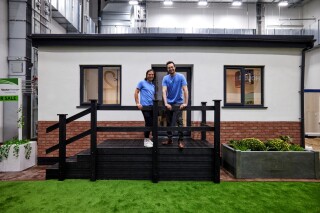What makes Vector Homes different from other flatpack homes is their use of graphene.
By incorporating graphene into the structures, the panels used in the construction of a Vector home have improved tensile strength, a reduced flame spread and increased UV resistance.
Vector Homes has been set up in Manchester by a pair of materials engineers with a background in graphene research and development. Chief executive Nathan Feddy worked in the nanocomposites division of the Graphene Engineering Innovation Centre; chief technology officer Liam Britnell was application manager at the Graphene Engineering Innovation Centre.
Vector has worked with the University of Manchester’s Graphene Engineering Innovation Centre to develop ways of incorporating the material into housing systems.
A prototype Vector house is now being assessed in the University of Salford’s Energy House 2.0 to test the thermal properties and its efficiency in different climates.
The prototype is a one-bedroom bungalow, measuring 40 sqm, constructed using recycled steel and plastics, as well as graphene and other advanced materials.
Vector’s ambition is to create an affordable, energy efficient home with low-embodied carbon materials, infra-red heating, solar cells, breathable mould-resistant plaster and render, and embedded technology to provide smart environmental controls that efficiently measure and control the temperature, humidity and air quality in each room.
Its homes are also designed for rapid production and assembly. Vector hopes to mass produce homes in a range of shapes and sizes that are sold as flatpack kits.

Launched earlier this year, the £16m Energy House 2.0, on the University of Salford’s Peel Park Campus, is helping to drive innovation in the housing sector already, through work with house-builders Barratt and Bellway, and manufacturer Saint-Gobain. It can recreate temperatures from -20C to 40C, as well as recreating snow, wind, rain and solar energy to put the Vector home through its paces.
Vector Homes has so far received backing from SFC Capital, GC Angels, the Greater Manchester Investment Fund which is the investment arm of the Greater Manchester Combined Authority, Innovate UK, the European Regional Development Fund and social housing investment firm HSPG.

Liam Britnell said: “Our mission is to cut carbon and costs in construction and our homes are designed to have 80% fewer carbon emissions in the building process compared to a standard brick house. They are also designed to be dismantled rather than demolished at the end of life, with the components finding a second or even third life elsewhere. From the microstructure to the superstructure of a Vector home, everything links back to efficiency and sustainability. Our homes will be super standardised to ensure the rapid production of components and assembly.
“The opportunity to work with Energy House 2.0 has been a dream come true. It’s a one-of-a-kind facility which enables testing for new types of construction methods.
“The Energy House 2.0 team have been incredible to work with, and in a few months’ time our housing system will have more empirical data than any other in the world. This will enable us to continue our iteration cycles to take Vector to the next level.”
Energy House Labs director Professor Will Swan said: “This type of project is exactly what our unique Energy House 2.0 facility was built for. Vector Homes is an ambitious, innovative northwest company and if we can help them to develop a new product which can provide cheap, safe and, most importantly, warm housing, then there will be huge benefits.”
Got a story? Email news@theconstructionindex.co.uk



